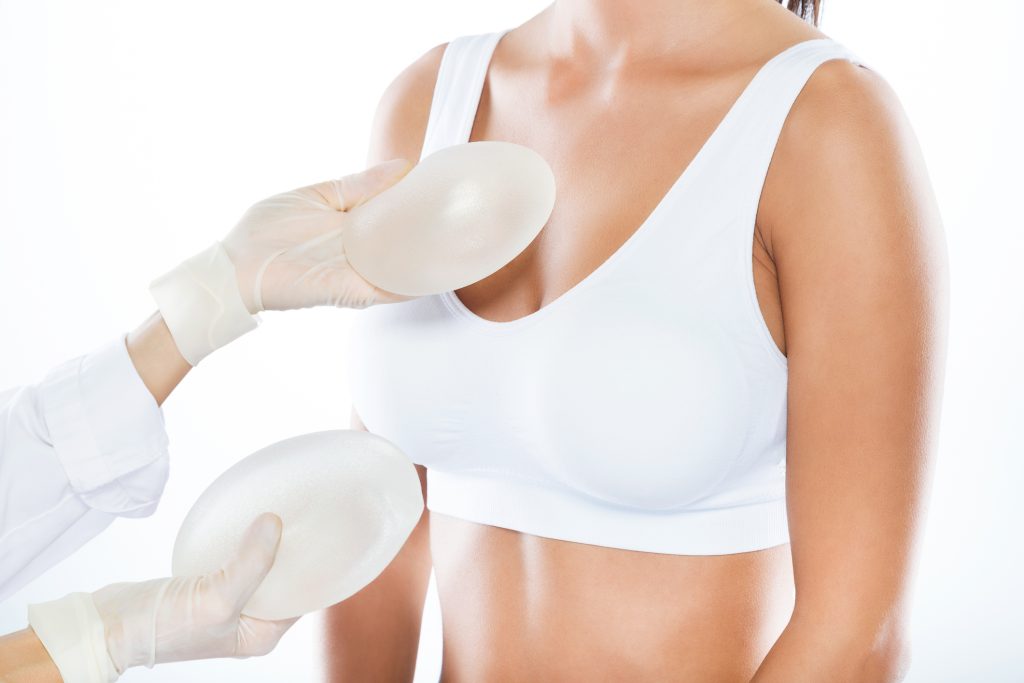As a board-certified plastic surgeon with fellowships in aesthetic, breast, and laser surgery, I have been on the cutting edge of breast augmentation surgery for more than three decades. In a typical week, I meet with dozens of patients seeking breast augmentation. Several questions and topics are discussed, with the most popular being “saline or silicone breast implants?” I take pride in empowering my breast augmentation patients to make informed choices. Here, I answer some of the top questions I hear so that you can be informed and empowered, too.
Which is better: saline or silicone implants?
SILICONE BREAST IMPLANTS
In general, the more popular choice among all age groups today is silicone. Silicone gel implants were first created in the late 1960s and continue to improve with ongoing technological advancement.
Silicone gel is a polymer with no known human allergies, sensitivities, or reactions. Similar to gummy bear candy, the molecules are stuck to one another in a cohesive matrix. This creates a natural look and feel to the breasts.
Silicone implants come in many shapes, sizes, and projections, allowing patients to customize and achieve their desired results.
SALINE BREAST IMPLANTS
Saline-filled implants were designed as an alternative to silicone and became popular in the 1990s and early 2000s.
Saline has the same consistency as water, which often leads to a rippled appearance under the breast tissue if the implant is underfilled. A major selling point for saline implants, however, is that some styles include ports that allow for the amount of saline to be adjusted after surgery.
Saline implants are less optimal for women seeking larger implants such as a D cup.
What is natural breast augmentation?
For some women, there’s an alternative to breast implants altogether: fat grafting, also called natural breast augmentation. It uses your own unwanted fat to increase your breast size. You can learn more about this option in our related blog post.
Are breast implants safe?
Breast implants are considered quite safe, but every medical device comes with risks. Manufacturers have made significant efforts to enhance the safety profiles of implants and reduce complications. This includes improvements in shell design, filler materials, and manufacturing processes.
Breast implants, both saline and silicone, are approved by regulatory authorities such as the U.S. Food and Drug Administration (FDA) in the United States. These regulatory bodies evaluate the safety and efficacy of implants before granting approval.
You may have heard about the recent reports of a potential association between breast implants and BIA-ALCL. It occurs most frequently in patients who have breast implants with textured surfaces. We have known about this disease for quite some time, and the Food and Drug Administration has been providing updates since 2011. In any case, as a precaution, I would not recommend textured implants. If you do have a textured implant, you are safe as long as you are happy with your cosmetic results and you do not develop late swelling with fluid collection around the breast. In those instances, visit your plastic surgeon for an evaluation.
How long do breast implants last?
While breast implants are not considered to be lifetime devices, they are designed to be durable. On average, breast implants have a lifespan of around 10 to 20 years. However, it’s important to note that this is an estimate and not a guarantee. Some implants may last longer, while others may require replacement earlier.
Silicone gel implants are generally believed to have a longer lifespan compared to saline implants. Cohesive silicone gel implants, in particular, are designed to be more durable and less prone to leakage.
Has silicone breast implant technology improved?
Over the last 20 years, significant advances have been made to silicone gel Implants. The newest silicone implants have a slightly higher fill (96% fill versus the previous generation’s 85% fill) and more cross-linking of the silicone molecules. The higher fill and more cross-linking allow for an increase in the cohesiveness of breast implants, as compared to past generations of implants, in which the folds of the silicone implant could be visible through the skin. Rippling was the only potential trade-off of placing silicone implants on top of the muscle in thin patients or after mastectomy – until now!
Excitingly, with the latest generation of silicone breast implants, there is much less rippling, even in very thin or athletic patients. These implants create a natural result for women desiring small, moderate, or even ample breast size.
You can see my breast implant patients’ before and after pictures in our online photo gallery.
What is breast augmentation recovery like?
The breast augmentation procedure requires a small incision, often in the crease below the breast, resulting in a tiny scar that is typically well hidden. Immediately following the procedure, an elastic sports bra is placed to minimize swelling and support the breasts as they heal.
Acute pain usually subsides after one to five days, but you may experience soreness and swelling for up to two weeks. Patients can resume exercise and regular activity based on my instruction within a few weeks.
Overall, my patients find that recovery is quick and reasonably straightforward following the breast augmentation procedure.
I’m Here To Answer Your Questions
Whether you are considering a breast augmentation for the first time or a patient with existing implants looking for a change, I look forward to sharing my experience and expertise in determining the most suitable breast augmentation option for you. Please contact my plastic surgery office in Lafayette to schedule a consultation at (925) 283-4012.


Leave a Reply